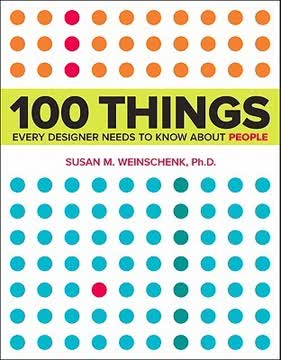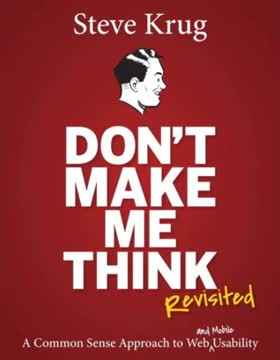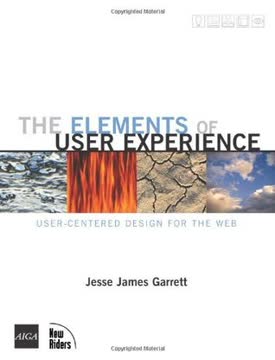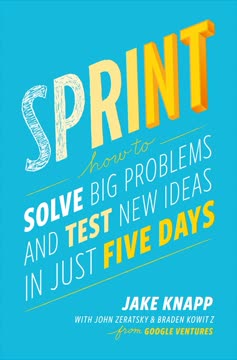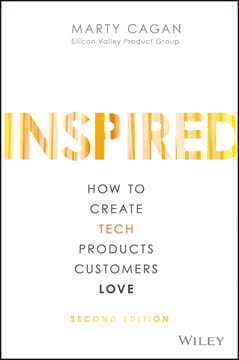نکات کلیدی
1. تحقیق تفکر انتقادی است، نه فقط جمعآوری داده
تحقیق تنها نام دیگری برای تفکر انتقادی است.
ماهیت تحقیق. تحقیق در طراحی به جمعآوری حجم زیادی از دادهها یا اثبات درست بودن خود مربوط نمیشود. بلکه به پرسشگری سیستماتیک برای افزایش دانش و اطلاعرسانی به تصمیمات مربوط میشود. تحقیق خوب نیاز به انضباط، شکاکیت و تمایل به به چالش کشیدن فرضیات دارد. این شامل پرسیدن سوالات درست، جمعآوری اطلاعات مرتبط و تحلیل انتقادی نتایج است.
اصول کلیدی:
- با اهداف و سوالات تحقیق واضح شروع کنید
- آماده باشید تا بر اساس یافتهها فرضیات خود را تغییر دهید
- بر کیفیت بینشها تمرکز کنید نه کمیت دادهها
- کل تیم را درگیر کنید تا درک مشترکی ایجاد شود
- از تحقیق برای کاهش ریسک و افزایش اعتماد به تصمیمات استفاده کنید
2. اهداف واضح را قبل از شروع هر تحقیقی تعریف کنید
اگر به دیگران برای تعیین دستور کار تحقیق تکیه کنید، ممکن است بین گروههای کانونی مبهم و الگوریتمی که سایهای از میان چهل و یک سایه آبی انتخاب میکند، گرفتار شوید.
اهداف واضح تحقیق مؤثر را هدایت میکنند. قبل از ورود به هر فعالیت تحقیقاتی، ضروری است که مشخص کنید چه چیزی را نیاز دارید بدانید و چرا. با شناسایی تصمیمات کلیدی که باید اتخاذ شوند و اطلاعات مورد نیاز برای انجام آنها با اطمینان شروع کنید. سوالات تحقیق خود را به گونهای فرموله کنید که خاص، قابل اقدام و عملی باشند.
مراحل تعریف اهداف تحقیق:
- مشکل یا فرصتی که به آن میپردازید را شناسایی کنید
- تصمیماتی که باید اتخاذ شوند را تعیین کنید
- فهرستی از فرضیات که باید تأیید شوند تهیه کنید
- سوالات تحقیق را بر اساس تأثیر بالقوه اولویتبندی کنید
- روشهای تحقیق مناسب برای پاسخ به آن سوالات را انتخاب کنید
به یاد داشته باشید که هدف انجام تحقیق به خاطر خود آن نیست، بلکه جمعآوری بینشهایی است که به طور مستقیم تصمیمات طراحی و تجاری شما را اطلاعرسانی میکند.
3. تحقیق سازمانی برای موفقیت پروژه حیاتی است
طراحی در خلأ عمیق و سرد فضا اتفاق نمیافتد. طراحی در نزدیکی گرم و عرقکرده افرادی با افکار بسیار اتفاق میافتد.
درک زمینه. تحقیق سازمانی به شما کمک میکند تا در زمینۀ انسانی پیچیدهای که طراحی شما در آن پیادهسازی خواهد شد، حرکت کنید. با درک ساختار، فرهنگ و اولویتهای سازمان، میتوانید چالشها را پیشبینی کرده و کار خود را با اهداف تجاری هماهنگ کنید.
مناطق کلیدی برای بررسی:
- نقشهبرداری از ذینفعان: شناسایی تصمیمگیرندگان و تأثیرگذاران کلیدی
- تحلیل جریان کار: درک فرآیندها و نقاط درد فعلی
- ارزیابی منابع: تعیین بودجه، زمان و مهارتهای موجود
- عوامل فرهنگی: کشف قوانین نانوشته و ارزشهای سازمانی
انجام تحقیق سازمانی جامع به شما کمک میکند تا متحدان بسازید، مخالفتهای بالقوه را خنثی کنید و شانس پذیرش و پیادهسازی موفق طراحی خود را افزایش دهید.
4. تحقیق کاربری همدلی ایجاد میکند و تصمیمات طراحی را اطلاعرسانی میکند
طراحی، کدنویسی و نوشتن به معنای پذیرش خطر، پیشروی به سمت ناشناخته و ساخت چیزهای جدید از مواد در حال تغییر مداوم است و هر روز خود را در معرض انتقاد و شکست قرار میدهد.
همدلی محرک نوآوری است. تحقیق کاربری به شما این امکان را میدهد که از دیدگاه خود خارج شوید و بهطور واقعی نیازها، رفتارها و زمینههای افرادی که برای آنها طراحی میکنید را درک کنید. این درک عمیق برای ایجاد راهحلهایی که با کاربران همخوانی داشته و مشکلات واقعی را حل کنند، حیاتی است.
تکنیکهای مؤثر تحقیق کاربری:
- مصاحبههای قومنگاری: درک کاربران در زمینه طبیعی خود
- پرسشگری زمینهای: مشاهده کاربران در حال انجام وظایف مرتبط
- طراحی مشارکتی: درگیر کردن کاربران در فرآیند طراحی
- نقشهبرداری از سفر: تجسم تجربه کاربر در طول زمان
به یاد داشته باشید که هدف تنها جمعآوری داده نیست، بلکه توسعه همدلی واقعی و بینشهایی است که هر جنبه از فرآیند طراحی شما را اطلاعرسانی میکند.
5. تحقیق رقابتی فرصتها و تهدیدها را شناسایی میکند
سختترین رقیب برای شکست دادن، رقیبی است که مشتریان بالقوه شما در حال حاضر از آن استفاده میکنند.
چشمانداز خود را بشناسید. تحقیق رقابتی به شما کمک میکند تا درک کنید محصول یا خدمات شما در اکوسیستم بازار گستردهتر کجا قرار میگیرد. این تنها به رقبای مستقیم مربوط نمیشود، بلکه شامل راهحلهای جایگزین و مختلکنندههای بالقوه نیز میشود.
اجزای کلیدی تحقیق رقابتی:
- تحلیل SWOT: ارزیابی نقاط قوت، ضعف، فرصتها و تهدیدها
- مقایسه ویژگیها: تحلیل اینکه چگونه پیشنهاد شما در برابر گزینههای دیگر قرار میگیرد
- درک ادراک کاربر: فهم اینکه مشتریان چگونه گزینههای مختلف را میبینند
- روندهای بازار: شناسایی فناوریهای نوظهور و نیازهای در حال تغییر کاربران
از بینشهای رقابتی برای تمایز پیشنهاد خود، پیشبینی تغییرات بازار و شناسایی نیازهای برآوردهنشده کاربران که نمایانگر فرصتهای نوآوری هستند، استفاده کنید.
6. تحقیق ارزیابی طراحیها را تصحیح و تأیید میکند
مهم نیست که چقدر تحقیق و تفکر طراحی هوشمندانه در ابتدا انجام دادهاید، شما نمیتوانید همه چیز را از ابتدا درست انجام دهید و این اشکالی ندارد.
تکرار و بهبود. تحقیق ارزیابی به شما کمک میکند تا راهحلهای طراحی خود را در طول فرآیند توسعه آزمایش و تصحیح کنید. این رویکرد تکراری به شما این امکان را میدهد که مشکلات کاربری را زود شناسایی کرده، تصمیمات طراحی را تأیید کنید و بهطور مداوم تجربه کاربری را بهبود بخشید.
روشهای کلیدی تحقیق ارزیابی:
- آزمایش قابلیت استفاده: مشاهده کاربران در حال تعامل با طراحی شما
- آزمایش A/B: مقایسه نسخههای مختلف برای بهینهسازی عملکرد
- ارزیابی هنجاری: ارزیابی طراحیها بر اساس اصول established
- بازخورد کاربر: جمعآوری ورودی کیفی از کاربران واقعی
به یاد داشته باشید که ارزیابی یک رویداد یکباره نیست، بلکه یک فرآیند مداوم در طول چرخه زندگی طراحی است. آماده باشید تا بر اساس آنچه یاد میگیرید تغییراتی ایجاد کنید.
7. تحلیل و مدلها دادههای خام را به بینشهای قابل اقدام تبدیل میکنند
تا زمانی که در مورد سوالات و انتظارات خود واضح باشید، نگران طبقهبندی تحقیقاتی که میخواهید انجام دهید نباشید.
دادهها را معنا کنید. تحلیل جایی است که شما دادههای خام تحقیق را به بینشهای معناداری تبدیل میکنید که میتوانند تصمیمات طراحی را هدایت کنند. این یک فرآیند همکاری است که شامل شناسایی الگوها، ترکیب اطلاعات و ایجاد مدلهایی است که نیازها و رفتارهای کاربران را نمایندگی میکند.
تکنیکها و مدلهای مفید تحلیل:
- نمودار همافزایی: گروهبندی و دستهبندی یافتههای تحقیق
- پرسونای کاربری: ایجاد کاربران آرکیتایپی برای نمایندگی بخشهای کلیدی
- مدلهای ذهنی: نقشهبرداری از فرآیندهای فکری و انتظارات کاربران
- نقشههای سفر مشتری: تجسم تجربه کاربر از ابتدا تا انتها
هدف تحلیل تنها خلاصهسازی یافتهها نیست، بلکه تولید بینشهای قابل اقدام است که بهطور مستقیم استراتژی و تصمیمات طراحی شما را اطلاعرسانی میکند.
8. نظرسنجیها میتوانند خطرناک باشند اگر به درستی طراحی و استفاده نشوند
نظرسنجی یک نظرسنجی است. نظرسنجی هرگز نباید به عنوان یک گزینه پشتیبان برای زمانی که نمیتوانید نوع درست تحقیق را انجام دهید، باشد—زیرا طراحی یک نظرسنجی خوب آسان نیست. نظرسنجیها سختترین روش تحقیق از همه هستند.
با احتیاط برخورد کنید. در حالی که نظرسنجیها میتوانند دادههای کمی ارزشمندی ارائه دهند، اغلب بهطور نادرست استفاده و تفسیر میشوند. نظرسنجیهای poorly designed میتوانند به نتایج گمراهکننده و اعتماد کاذب به تصمیمات منجر شوند.
ملاحظات کلیدی برای نظرسنجیهای مؤثر:
- اهداف واضح: تعریف کنید که چه چیزی را نیاز دارید یاد بگیرید و چرا
- نمونهگیری مناسب: اطمینان حاصل کنید که پاسخدهندگان شما نماینده جمعیت هدف شما هستند
- سوالات خوب طراحیشده: از تعصب پرهیز کنید و وضوح را تضمین کنید
- تحلیل مناسب: از روشهای آماری صحیح استفاده کنید
- تفسیر زمینهای: نتایج را در کنار سایر تحقیقات در نظر بگیرید
به یاد داشته باشید که نظرسنجیها تنها یکی از ابزارها در جعبهابزار تحقیق هستند. آنها زمانی بهترین کارایی را دارند که با روشهای کیفی که بینشهای عمیقتری از انگیزهها و رفتارهای کاربران ارائه میدهند، ترکیب شوند.
9. تحلیلها دادههای کمی را برای بهینهسازی طراحیها فراهم میکنند
فقط به این دلیل که چیزی قابل اندازهگیری است، به این معنا نیست که معنادار است؛ پیگیری معیارهای نادرست میتواند بدتر از عدم پیگیری هیچ چیزی باشد.
تصمیمات مبتنی بر داده. تحلیلها به شما این امکان را میدهند که رفتار واقعی کاربران را اندازهگیری کرده و طراحی خود را بر اساس عملکرد واقعی بهینه کنید. با این حال، ضروری است که بر روی معیارهای معناداری که با اهداف تجاری و نیازهای کاربران همراستا هستند، تمرکز کنید.
اصول کلیدی برای استفاده مؤثر از تحلیلها:
- اهداف و KPIهای واضحی را تعریف کنید که با اهداف تجاری همراستا باشند
- فراتر از معیارهای ظاهری بروید و بر روی بینشهای قابل اقدام تمرکز کنید
- دادههای کمی را با تحقیقات کیفی برای زمینهسازی ترکیب کنید
- از آزمایش A/B برای تأیید تغییرات طراحی استفاده کنید
- بهطور مداوم بر اساس دادههای عملکرد نظارت و تنظیم کنید
به یاد داشته باشید که تحلیلها ابزاری قدرتمند هستند، اما باید اطلاعرسانی کنند، نه اینکه قضاوت انسانی و تخصص طراحی را جایگزین کنند. همیشه زمینه وسیعتر و پیامدهای ناخواسته احتمالی تلاشهای بهینهسازی را در نظر بگیرید.
آخرین بهروزرسانی::
FAQ
What's "Just Enough Research" about?
- Overview: "Just Enough Research" by Erika Hall is a guide to conducting effective research in design and product development. It emphasizes practical, efficient methods that can be integrated into everyday work.
- Purpose: The book aims to demystify research, making it accessible to non-researchers and helping teams make informed decisions based on evidence rather than assumptions.
- Content Structure: It covers various types of research, including user, competitive, and evaluative research, and provides guidance on analysis, surveys, and analytics.
- Target Audience: The book is intended for designers, developers, and anyone involved in product development who wants to incorporate research into their process without becoming overwhelmed.
Why should I read "Just Enough Research"?
- Practical Guidance: The book offers actionable advice on how to conduct research efficiently, making it ideal for busy professionals who need to integrate research into their workflow.
- Demystifies Research: Erika Hall breaks down complex research concepts into understandable and manageable parts, making it accessible to those without a research background.
- Improves Decision-Making: By focusing on evidence-based decision-making, the book helps teams avoid costly mistakes and assumptions, leading to better product outcomes.
- Encourages Critical Thinking: It fosters a mindset of continuous questioning and learning, which is crucial for innovation and staying competitive in the market.
What are the key takeaways of "Just Enough Research"?
- Research as a Tool: Research is a tool for critical thinking and should be used to inform decisions, not just validate preconceived ideas.
- Types of Research: The book outlines different types of research, such as user, competitive, and evaluative, and when to use each.
- Collaboration is Key: Effective research requires collaboration and shared understanding among team members to ensure insights are applied effectively.
- Bias Awareness: Recognizing and mitigating biases in research is crucial for obtaining accurate and useful insights.
How does Erika Hall define research in "Just Enough Research"?
- Systematic Inquiry: Research is defined as systematic inquiry aimed at increasing knowledge about a particular topic.
- Types of Research: It includes pure research for new knowledge, applied research for real-world goals, and design research focused on user-centered design.
- Purpose of Design Research: Design research is about understanding the people for whom products are designed, focusing on their behaviors, needs, and contexts.
- Critical Thinking: Research is equated with critical thinking, emphasizing the importance of asking the right questions and seeking evidence-based answers.
What is the process of conducting research according to "Just Enough Research"?
- Define the Problem: Start with a clear problem statement that describes the topic and goal of the research.
- Select the Approach: Choose the appropriate type of research based on the problem statement and available resources.
- Plan and Prepare: Develop a research plan, including roles, recruitment, and materials needed for data collection.
- Collect and Analyze Data: Gather data through interviews, observations, or testing, and analyze it to identify patterns and insights.
How does "Just Enough Research" address common objections to research?
- Time and Money Concerns: The book argues that research saves time and money in the long run by preventing costly mistakes and rework.
- Lack of Expertise: It emphasizes that anyone can conduct research with the right mindset and tools, and provides guidance to develop necessary skills.
- Fear of Being Wrong: Encourages embracing being proven wrong as a learning opportunity, which leads to better decision-making.
- Infrastructure Needs: Suggests using existing tools and processes for research, highlighting that special infrastructure is not necessary.
What is the role of collaboration in research according to "Just Enough Research"?
- Shared Understanding: Collaboration ensures that insights are shared and understood by all team members, leading to more effective application.
- Roles and Responsibilities: Clearly defined roles and responsibilities within the research process help maintain focus and quality.
- Healthy Conflict: Encourages healthy conflict and questioning within teams to strengthen design decisions and avoid groupthink.
- Continuous Learning: Collaboration fosters a culture of continuous learning and questioning, which is essential for innovation.
How does "Just Enough Research" suggest handling biases in research?
- Acknowledge Bias: Recognize that bias is inherent in research and take steps to identify and mitigate it.
- Design Bias: Be aware of how personal goals or preferences can influence the design of studies and the interpretation of data.
- Sampling Bias: Ensure that research participants are representative of the target audience to avoid skewed results.
- Social Desirability Bias: Encourage honesty and confidentiality to reduce the influence of participants wanting to present themselves favorably.
What are the best quotes from "Just Enough Research" and what do they mean?
- "Make friends with reality": This quote emphasizes the importance of understanding the real-world context and constraints when conducting research and designing products.
- "Research is just another name for critical thinking": Highlights that research is about asking the right questions and seeking evidence-based answers, not just gathering data.
- "Questions are more powerful than answers": Encourages a mindset of continuous inquiry and learning, which is crucial for innovation and effective problem-solving.
- "The right questions keep you honest": Stresses the importance of questioning assumptions and seeking evidence to guide decision-making and avoid costly mistakes.
How does "Just Enough Research" differentiate between qualitative and quantitative research?
- Qualitative Research: Focuses on understanding behaviors, needs, and motivations through methods like interviews and observations. It provides rich, detailed insights.
- Quantitative Research: Involves measuring and analyzing numerical data to identify patterns and trends. It is useful for validating hypotheses and making generalizations.
- Complementary Methods: The book suggests using both methods together to gain a comprehensive understanding of user needs and behaviors.
- Bias and Limitations: Highlights the potential biases and limitations of each method and the importance of choosing the right approach for the research question.
What is the significance of user research in "Just Enough Research"?
- Understanding Users: User research helps designers understand the true needs, priorities, and contexts of their target audience.
- Empathy Development: It fosters empathy by allowing designers to see the world from the user's perspective, leading to more user-centered designs.
- Informed Decision-Making: Provides evidence-based insights that guide design decisions and reduce the risk of assumptions leading to poor outcomes.
- Continuous Improvement: Encourages ongoing user research to adapt to changing user needs and improve products over time.
How does "Just Enough Research" suggest using surveys effectively?
- Clear Objectives: Start with a clear research objective and ensure that the survey questions align with this goal.
- Question Design: Write simple, specific questions that are easy for respondents to understand and answer truthfully.
- Sampling Considerations: Be mindful of sampling bias and ensure that the survey sample is representative of the target population.
- Data Analysis: Analyze survey data carefully, considering potential biases and limitations, to draw meaningful conclusions.
نقد و بررسی
کتاب فقط به اندازهی کافی تحقیق عمدتاً نظرات مثبتی دریافت کرده و به خاطر پوشش مختصر اما جامع خود از روشهای تحقیق در زمینهی تجربه کاربری (UX) مورد تحسین قرار گرفته است. خوانندگان به دسترسی آسان، مشاورههای عملی و سبک نوشتاری جذاب آن ارج مینهند. بسیاری این کتاب را برای مبتدیان ارزشمند و به عنوان مرجع سریع برای حرفهایهای با تجربه میدانند. برخی آن را به خاطر سادگی بیش از حد یا کمبود عمق در برخی زمینهها مورد انتقاد قرار دادهاند. بهطور کلی، این کتاب به کسانی که به دنبال درک یا بهبود رویکرد خود به تحقیق کاربر هستند، توصیه میشود و بهویژه بخشهای آن در مورد تحقیق سازمانی و رقابتی مورد تحسین قرار گرفته است.
A Book Apart Series Series
Similar Books
